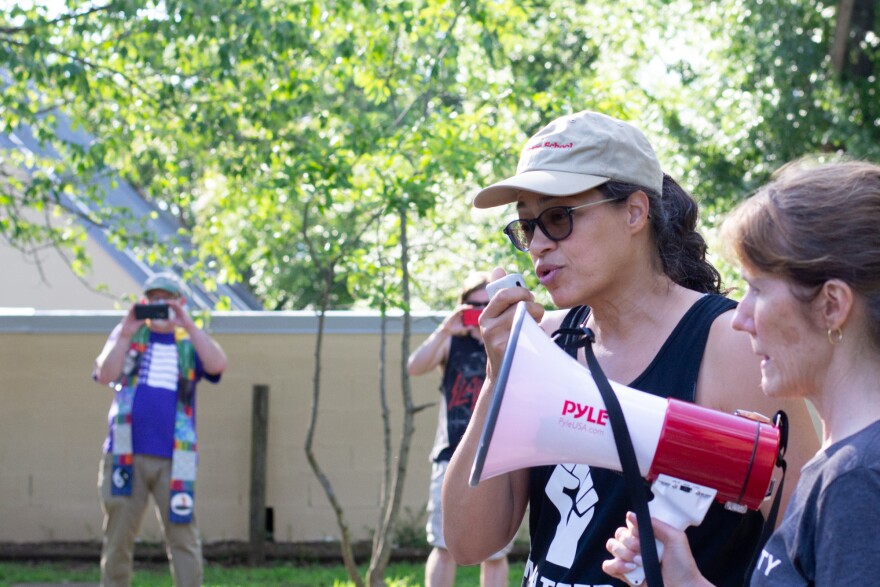Friday was the fifth anniversary of the violent Unite the Right rally in Charlottesville. Community groups and clergy organizations came together to host a walking vigil marking the event. WMRA's Randi B. Hagi reports.
CROWD CHANTING: Hey, hey! Ho, ho! White supremacy has got to go!
The walkers included pastors, professors, activists, and authorities – many of whom were present when the violence unfolded in Charlottesville in August 2017. Volunteers in neon safety vests guided around 175 marchers along a winding, one-mile walk that included significant sites from the resistance to the Unite the Right rally.

At the Jefferson School, former city council member Wes Bellamy addressed the crowd with his young daughter riding on his shoulders.
WES BELLAMY: I firmly believe that white supremacy will be rooted out. In fact, we've already done much of so on August 12 and August 13. Case in point – we're here. They're not. [cheers]
They walked on to McGuffey Park, where Jalane Schmidt spoke – she's the director of UVa's Memory Project, and one of the leaders of the Swords into Plowshares initiative, which plans to melt down the statue of Robert E. Lee, and use it to create a new work of art. The statue was the symbolic lightning rod for the white supremacists who came to 'Unite the Right.'

JALANE SCHMIDT: And that was their pretext, right? They even said, "well, you know, it was about kinda bringing people to our movement." But those statues were like a homing beacon for racists. We knew that, and that's why we wanted to get rid of them, because we're a kind of people that wants to be inclusive.
The next stop was First United Methodist Church, which had been open as a recovery space for counter-protestors five years ago.
PHIL WOODSON: All day long, street medics were bringing people back with their faces beaten … blood everywhere. Car attack victims who were not taken to the hospital were brought back here.
The Reverend Phil Woodson was one of the church's associate pastors at the time.

WOODSON: Even when there were horrible fights happening over here along the bushes, even when cars came up onto the curb and we saw them driving by with guns and weapons … All of these things were happening, but there were still good people doing good work.
Mental and physical healthcare providers were stationed at the church, volunteering their services. Among them was Cali Gaston, a nurse and acupuncturist. She remembers the aftermath of the car, driven by a terrorist, plowing into the crowd on 4th Street, which is now named after Heather Heyer.
CALI GASTON: … Obviously anybody who was hurt enough wasn't coming to an acupuncture clinic – they were headed for the hospital. But the people that I was treating, you know, there were bruises and lots of tears and clearly a very high level of trauma.

The next stop was Market Street Park – where the Lee statue formerly stood.
[group singing Jewish song "Olam Chesed Yibaneh"]
There, the Reverend Brenda Brown-Grooms read a Bible passage from the book of Isaiah, and drew a throughline to Charlottesville's struggle for racial justice.
BRENDA BROWN-GROOMS: In, what, 24, 1924, a statue of Robert E. Lee and his horse, Traveler, went up in this park. And it stayed there all of my childhood, and I never even walked in this park until 2017. I ask you, my brothers and sisters, where is that statue now? Is it here?
CROWD: No!

BROWN-GROOMS: … Is Traveler here?
CROWD: No!
BROWN-GROOMS: Do our eyes deceive us?
CROWD: No!
BROWN-GROOMS: It's not here! They that wait upon the Lord will renew their strength! They shall mount up on wings like eagles! They shall walk and not faint! They will run and not be weary! [cheers]
From there, the group walked to the Congregation Beth Israel, where Rabbi Tom Gutherz was playing guitar and singing before their evening service in support of the vigil.
[sound of guitar, congregation singing]

Finally, the group descended on Heather Heyer Way, filling the street and singing as they approached the place where she was killed.
[group singing "Courage My Friend"]
Flowers, chalk messages, and paper hearts with notes to Heyer written on them adorned the sidewalk. Activist Don Gathers said a prayer.
DON GATHERS: And we ask you Lord that, right now, that you would indeed just touch each and every heart and head that's assembled here. Give them the strength and the peace that they seek, dear Lord. Give them the courage, just as, as – [pauses] – just as you gave Heather that day.
The vigil was followed by an interfaith worship service titled, "Unite the Light."
[group singing "This Little Light of Mine"]



